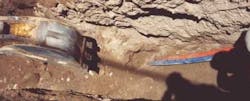Service provider MediaCom suffers two fiber cable cuts within an hour
News outlets including the Houston Chronicle and the St. Louis Post-Dispatch reported this week on coincidental fiber cable cuts within an hour of each other that affected tens of thousands of Mediacom internet and television customers in three states.
The Houston Chronicle reported that customers in Georgia, Illinois and Missouri experienced service interruptions “after a pair of large fiber-optic cables were accidentally cut.” First a mower in a road crew near Fitzgerald, Georgia cut a cable, the Chronicle reported. Then less than an hour later, a construction crew near Carrollton, Missouri cut another line.
The news outlet quoted Mediacom spokeswoman Phyllis Peters as saying the nearly coincidental cuts were “very unusual.”
The Post-Dispatch noted that the cut lines “caused video problems for about 140,000 customers in Missouri and Illinois and internet troubles for an unknown number [while] the Georgia incident interrupted service for up to 36,000 customers and internet service for as many as 15,000.”
In an article we published in June 2012, fiber expert Eric R. Pearson, CFOS dubbed this type of incident “back hoe fade.” In the article, titled “15 lessons from lawsuits involving fiber-optic installations,” he explains, “All cables are susceptible to breakage. The form specific to underground cables is (a very rapid) back hoe fade, or unintentional severing of a cable by a back hoe or other piece of construction equipment. This situation leads to three lessons. One lesson involves the handling of the breakage situation. Snagging, breaking and burying a broken cable are not viable solutions. Logic and/or witnesses will identify the responsible party. Guaranteed.
“A second lesson involves the minimum action taken prior to construction. At this time, the installer can document the marked cable locations. Without such evidence, defense will be difficult and expensive.
“A third lesson is photographing the incident. Almost everyone has a cell phone or a digital camera to document the situation. At the time of a cable hit, the installer can document actual locations and depths. With photographs before and after, the actual position of the cable will be known. If the cable is not located in the position or at the depth that its owner has indicated, the installer may not be liable for the damage.”
